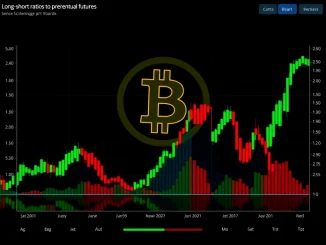
The crypto world is buzzing as Bitcoin’s price demonstrates remarkable resilience, holding firm above the crucial $115,000 mark. After a recent 7% dip from its $119,500 peak, many wondered if a deeper correction was on the horizon. However, the market’s response has been clear: strong institutional interest and favorable on-chain dynamics are providing a robust safety net. This isn’t just a fleeting moment; it’s a testament to Bitcoin’s evolving maturity and its growing appeal to serious investors.
Bitcoin Price: Navigating Volatility with Strength
Bitcoin’s journey in recent weeks has been a rollercoaster, yet its ability to stabilize above $115,000 speaks volumes. The cryptocurrency experienced a significant 7% decline from a high of $119,500, a move that typically sends shivers down the spine of many traders. This volatility was amplified by broader macroeconomic pressures and notable events, including $721 million in long liquidations as Bitcoin briefly slipped below $116,000 [2]. Furthermore, a substantial offloading of 80,000 BTC (valued at $1.39 billion) by Galaxy Digital in early July added considerable downward pressure, pushing the Bitcoin price towards the $115,000 level [3]. Despite these challenges, Bitcoin’s steadfast hold on this support level highlights a powerful underlying conviction among key market participants. It suggests that while short-term movements can be dramatic, a deeper, more strategic buying interest is at play, anchoring the asset.
Why $115,000 is a Critical Bitcoin Support Zone
What makes the $115,000 level so significant for Bitcoin? Analysts are pointing to a confluence of factors that establish this price point as a critical Bitcoin support zone.
- On-Chain Dynamics: The Unspent Transaction Output (UTXO) distribution, a key on-chain metric, indicates a notable void in activity around the $110,000–$115,000 range. This “void” suggests a reduced probability of large-scale sell-offs from existing holders, effectively creating a natural floor. On-chain analyst Burak Tamaç highlighted this, reinforcing the psychological importance of the $115,000 threshold [1].
- Psychological Significance: Beyond technical indicators, $115,000 has become a focal point for both institutional and retail market participants. It’s a level where buyers are stepping in decisively, signaling strong confidence in Bitcoin’s long-term value.
- Resilience Post-Drops: The asset’s immediate rebound and stabilization after the 7% drop from $119,500 demonstrates that this isn’t just a temporary bounce but a concerted effort to defend a crucial price point.
The Power of Institutional Bitcoin Buying
The stability seen at $115,000 is largely attributed to robust institutional Bitcoin demand. While retail investors play a role, it’s the strategic maneuvers of larger entities that often provide the necessary liquidity and conviction to absorb selling pressure. Even amidst reports of ETF outflows, derivatives data indicated a balanced risk exposure, suggesting that institutional players might be rebalancing or accumulating through other channels [2]. This institutional conviction is a game-changer for Bitcoin’s market structure. Their entry brings:
- Increased Capital Inflow: Institutions command significant capital, capable of absorbing large sell orders and pushing prices higher.
- Long-Term Perspective: Unlike some retail traders, institutions often have longer investment horizons, reducing short-term speculative volatility.
- Validation: Their participation lends credibility to Bitcoin as a legitimate asset class, attracting further mainstream adoption.
The market’s ability to hold $115,000 despite substantial selling pressure, like Galaxy Digital’s offloading, underscores this powerful institutional buying interest [3].
Understanding Crypto Market Trends and Their Impact
Bitcoin’s performance doesn’t occur in a vacuum; it’s intricately linked to broader crypto market trends and macroeconomic conditions. While Bitcoin has shown remarkable resilience, other assets have experienced varied fortunes:
- Ethereum’s Rebound: Ethereum, the second-largest cryptocurrency, saw a rebound from a low of $3,500, indicating some renewed bullish sentiment in the altcoin market.
- XRP’s Decline: Conversely, XRP experienced a 5% decline, reflecting a risk-off sentiment that affected some parts of the market.
- Macroeconomic Headwinds: The crypto market, including Bitcoin, continues to grapple with macroeconomic uncertainties. ETF outflows, for instance, have tempered optimism, as investors re-evaluate their risk appetites [4].
This interplay of internal crypto dynamics and external economic factors creates a complex environment for traders. Bitcoin’s impressive year-to-date surge of 23%, outperforming major equities, reinforces its appeal as a high-risk, high-reward asset, yet these broader trends highlight the need for cautious navigation.
What On-Chain Data Reveals About Bitcoin’s Future
Beyond price charts, on-chain data provides a deeper look into the health and potential future movements of Bitcoin. As mentioned earlier, the UTXO distribution’s “void” around $110,000-$115,000 is a significant bullish signal, suggesting fewer coins are likely to be sold in that range [1]. This analytical approach helps to distinguish between mere price fluctuations and fundamental shifts in market structure.
Analysts remain divided on the near-term outlook. Some view $115,000 as a strong potential floor for further consolidation, a base from which Bitcoin could launch its next leg up. Others caution that a deterioration of macroeconomic conditions or increased derivative exposure could still trigger renewed volatility [5]. Historical precedents, such as Bitcoin reaching the $120,000 milestone, often influence future market cycles. However, the current $115,000 support is unique due to its strong alignment with these specific on-chain gaps and the visible institutional activity. Crowdwisdom360 analysts emphasize the inherent leverage and liquidation risks in crypto trading, urging investors to constantly monitor key levels and sentiment shifts [5].
The Road Ahead: Stability or Volatility?
Bitcoin’s ability to hold above $115,000 is a critical development, showcasing a fascinating interplay between technical indicators, on-chain insights, and broader macroeconomic factors. As institutional players continue to anchor their strategies around this threshold, the market’s sustained defense of this level will be a key determinant. Will $115,000 serve as the springboard for a new bull phase, or is it merely a temporary consolidation point before further challenges? Only time will tell, but for now, Bitcoin’s resilience offers a beacon of stability in an otherwise dynamic market. Investors and enthusiasts alike will be watching closely to see if this newfound strength translates into sustained upward momentum.
Disclaimer: The news articles available on this platform are generated in whole or in part by artificial intelligence and may not have been reviewed or fact checked by human editors. While we make reasonable efforts to ensure the quality and accuracy of the content, we make no representations or warranties, express or implied, as to the truthfulness, reliability, completeness, or timeliness of any information provided. It is your sole responsibility to independently verify any facts, statements, or claims prior to acting upon them. Coin Pulse Fintech Inc expressly disclaims all liability for any loss, damage, or harm arising from the use of or reliance on AI-generated content, including but not limited to direct, indirect, incidental, or consequential damages.
Frequently Asked Questions (FAQs)
Q1: Why is the $115,000 level significant for Bitcoin’s price?
A1: The $115,000 level is significant because it has demonstrated robust support, driven by strong institutional demand and favorable on-chain dynamics, particularly a “void” in UTXO activity that reduces the likelihood of large sell-offs.
Q2: How did institutional investors influence Bitcoin’s stability at $115,000?
A2: Institutional investors played a crucial role by strategically buying at this level, absorbing selling pressure from events like Galaxy Digital’s BTC offloading and providing a strong buy-side interest that stabilized the price.
Q3: What are UTXO dynamics and how do they relate to Bitcoin’s support?
A3: UTXO (Unspent Transaction Output) dynamics refer to the distribution of unspent Bitcoin transactions. A “void” in UTXO activity around a certain price range, as seen near $115,000, suggests fewer coins are likely to be sold at that level, reinforcing it as a strong support zone.
Q4: What role do macroeconomic factors and ETF outflows play in Bitcoin’s price movements?
A4: Macroeconomic factors and ETF outflows contribute to market volatility and shifting risk appetites. While institutional buying can counter some pressure, these broader trends can temper optimism and influence Bitcoin’s short-term consolidation or declines.
Q5: What are the risks associated with current Bitcoin trading?
A5: Current Bitcoin trading still carries inherent risks, including leverage and liquidation risks, especially given the ongoing macroeconomic uncertainties and potential for increased derivative exposure. Investors are advised to monitor key levels and sentiment shifts.



